...did you have doubts?It turns out that you ARE teachable!
You are using an out of date browser. It may not display this or other websites correctly.
You should upgrade or use an alternative browser.
You should upgrade or use an alternative browser.
Kingfisher 1770 1:48 POF
- Thread starter dockattner
- Start date
- Watchers 144
- Joined
- Oct 15, 2017
- Messages
- 1,055
- Points
- 443

Why does it sound adventurous when you say it? It seemed like a good idea at the time.I reject that last statement...you built a hull with a staple gun.

Thank you kindly my friend!Just catching up with your build now Paul. Love watching any form of planking, a fascinating process. Learning new thing all the time, your planking looks superb!
Well, the (half) hull has been closed in. I learned a lot and can see places where I could have done better. But I found this exercise surprisingly taxing and often 'heard' myself thinking, good enough... Perhaps things will sort themselves out during sanding. But first, a few weeks installing treenails...
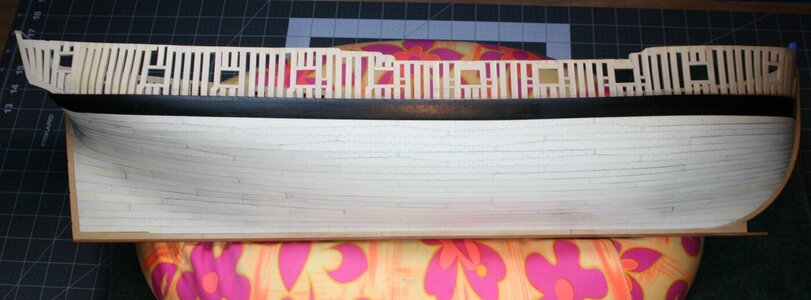
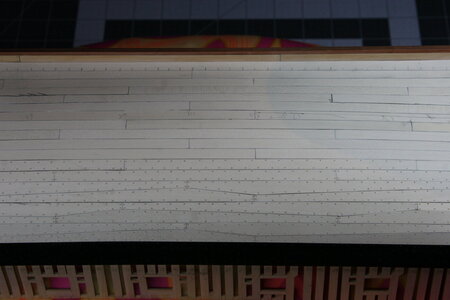
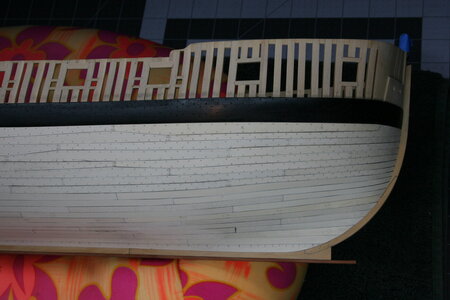
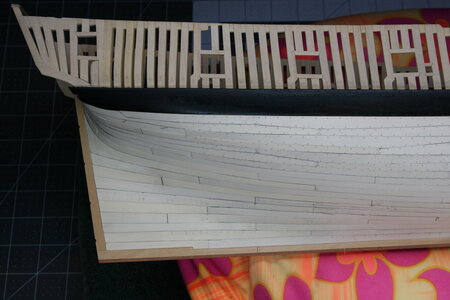
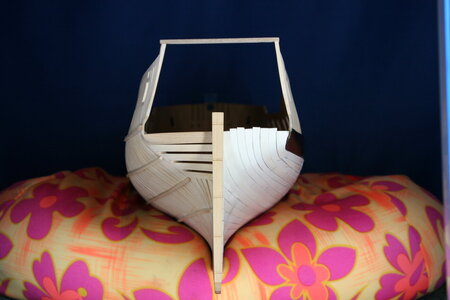
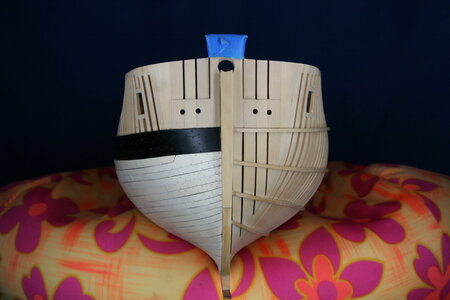
Thanks for stopping by!






Thanks for stopping by!
Looks great Paul, I particularly like the planking and tree-nailing.
- Joined
- Oct 15, 2017
- Messages
- 1,055
- Points
- 443

Paul, super results!Well, the (half) hull has been closed in. I learned a lot and can see places where I could have done better. But I found this exercise surprisingly taxing and often 'heard' myself thinking, good enough... Perhaps things will sort themselves out during sanding. But first, a few weeks installing treenails...
View attachment 405651
View attachment 405648
View attachment 405649
View attachment 405650
View attachment 405653
View attachment 405652
Thanks for stopping by!
 So aesthetically pleasing to the eye. I do understand you've traded some historical accuracy for artistic creativity, and I applaud it!
So aesthetically pleasing to the eye. I do understand you've traded some historical accuracy for artistic creativity, and I applaud it! I do have a few questions, not judgmental at all, just out of curiosity. I noticed the transition from Top and Butt planking to conventional somewhere around frame 10, forward. What drove your decision to implement the transition? Not being familiar with the Swan class standards, but understanding that 1770 copper cladding was in use, did this class of ship not use it, or was this a personal and artistic decision on your part? Honestly, I LOVE the use of Holly instead of "white washing" the hull!
All in all, you never disappoint with your results. But, inquiring minds need to know and I am an inquiring mind.
Hi Ken,Paul, super results!So aesthetically pleasing to the eye. I do understand you've traded some historical accuracy for artistic creativity, and I applaud it!
I do have a few questions, not judgmental at all, just out of curiosity. I noticed the transition from Top and Butt planking to conventional somewhere around frame 10, forward. What drove your decision to implement the transition? Not being familiar with the Swan class standards, but understanding that 1770 copper cladding was in use, did this class of ship not use it, or was this a personal and artistic decision on your part? Honestly, I LOVE the use of Holly instead of "white washing" the hull!
All in all, you never disappoint with your results. But, inquiring minds need to know and I am an inquiring mind.Oh and your treenails have a nice contrast with the Holly. Lots of impressive/difficult spilling done. KUDOS!
I appreciate your careful review! The only exterior planking expansion of a swan class ship that I have ever seen is the one posted earlier in this log by Christian (post #1395). It is of the Hornet (1776) and while this important document has apparently now been 'lost' by the NMM it informed the following drawing in Volume 3 of TFFM (Antscherl), pp 14-15:
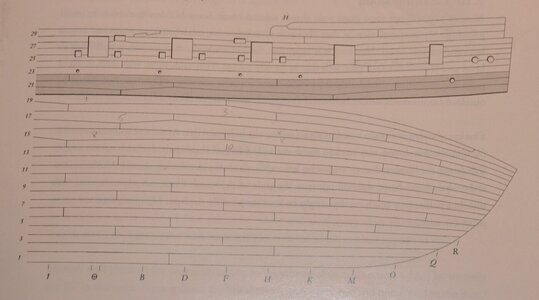
As you can see the top and butt pattern does not extend all the way to the stem (or to the stern for that matter). And truth be told I was glad for that - it would have been beyond difficult to preserve the pattern while spiling the forward planks.
Now, as for copper plates...per Antscherl (Vol 3, p 31ff) copper sheathing became required on frigates in 1779 and on all new ships in 1782. Kingfisher is the second in the series so in 1770 she would not have had copper plates when originally launched. Of course, we see many swan class ships on our forum with copper plates. This is in no way a mistake - especially for ships built later in the series, or if the modeler wants to show the ship after a refit or repair. Or, for that matter, if the modeler happens to like copper plates on a hull.
As it turns out I'm not a raving fan of cooper sheathed hulls, so I got lucky! In this case the absence of plates on my ship is not a sin of omission. Sometimes history can be your friend!

Postscript: as I understand it, copper sheathing did appear on British ships prior to 1779 - but it was an exception and not the standard. Shipbuilders were still working out the best formulation for the copper and the degrading effects of electrolytic action was a problem pending resolution... Or so my resources claim...
Last edited:
- Joined
- Sep 3, 2021
- Messages
- 4,907
- Points
- 688

No need to be too "picky" about the use of toothpicks.The first thing I was thinking about is that a 'first-dentist-then-orthodontist' would for sure use toothpicks
- Joined
- Sep 3, 2021
- Messages
- 4,907
- Points
- 688

...did you have doubts?

Maybe a little bit off topic (sorry for this Paul), but I think it could be interesting for freinds interested in such planking and existing contemporary drawings showing such details.....
Therefore please take a look at this older topic, where I put together several interesting examples of contemorary drawings
Therefore please take a look at this older topic, where I put together several interesting examples of contemorary drawings
OUTBOARD and INBOARD PLANKING expansion - contemporary drawings of real ships
During the research for our Naval History Topic, I found interesting contemporary drawings showing the outboard and inboard planking expansion of the 44-gun two-decker frigate HMS Woolwich (1785), an Adventure-class - which shows in detail the planking of the real ship at this time. Maybe we...
shipsofscale.com
Witaj
Piękne deskowanie Pawle z niecierpliwością czekam na kolejne zdjęcia po wyczyszczeniu i pełnym kołkowaniu efekt będzie super .Pozdrawiam Mirek
Hello
Beautiful formwork, Paweł, I'm looking forward to the next photos, after cleaning and full pinning, the effect will be great. Regards, Mirek
Piękne deskowanie Pawle z niecierpliwością czekam na kolejne zdjęcia po wyczyszczeniu i pełnym kołkowaniu efekt będzie super .Pozdrawiam Mirek
Hello
Beautiful formwork, Paweł, I'm looking forward to the next photos, after cleaning and full pinning, the effect will be great. Regards, Mirek
Last edited by a moderator:
Good afternoon Uwek. Awesome link. It looks like Paul got his Kingfisher spot on when I see the swan class hull in this link. Ha, it is Paul there should be no doubts hereMaybe a little bit off topic (sorry for this Paul), but I think it could be interesting for freinds interested in such planking and existing contemporary drawings showing such details.....
Therefore please take a look at this older topic, where I put together several interesting examples of contemorary drawings
OUTBOARD and INBOARD PLANKING expansion - contemporary drawings of real ships
During the research for our Naval History Topic, I found interesting contemporary drawings showing the outboard and inboard planking expansion of the 44-gun two-decker frigate HMS Woolwich (1785), an Adventure-class - which shows in detail the planking of the real ship at this time. Maybe we...shipsofscale.com
Good afternoon Paul. Brilliant. Plenty of tapering, bevelling, make those spiller planks and bending with this planking. A lot of work and wonderfully pulled off. Seeing Uweks post, from my layman’s perspective you got the Swan class pattern spot on.Well, the (half) hull has been closed in. I learned a lot and can see places where I could have done better. But I found this exercise surprisingly taxing and often 'heard' myself thinking, good enough... Perhaps things will sort themselves out during sanding. But first, a few weeks installing treenails...
View attachment 405651
View attachment 405648
View attachment 405649
View attachment 405650
View attachment 405653
View attachment 405652
Thanks for stopping by!
What a wonderful resource you produced Uwe! There are so many treasures to be found on this forum (including you).Maybe a little bit off topic (sorry for this Paul), but I think it could be interesting for freinds interested in such planking and existing contemporary drawings showing such details.....
Therefore please take a look at this older topic, where I put together several interesting examples of contemorary drawings
OUTBOARD and INBOARD PLANKING expansion - contemporary drawings of real ships
During the research for our Naval History Topic, I found interesting contemporary drawings showing the outboard and inboard planking expansion of the 44-gun two-decker frigate HMS Woolwich (1785), an Adventure-class - which shows in detail the planking of the real ship at this time. Maybe we...shipsofscale.com
Thank you Mirek. It's hard to be patient and delay the sanding...Witaj
Piękne deskowanie Pawle z niecierpliwością czekam na kolejne zdjęcia po wyczyszczeniu i pełnym kołkowaniu efekt będzie super .Pozdrawiam Mirek
Thank you kindly, Grant. I don't know if I'll ever add copper plates to a model or not. Every once in a while someone will get the look just right and it peaks my interest...but more times than not I think, "but you just planked a beautiful hull!"Good afternoon Paul. Brilliant. Plenty of tapering, bevelling, make those spiller planks and bending with this planking. A lot of work and wonderfully pulled off. Seeing Uweks post, from my layman’s perspective you got the Swan class pattern spot on.. I am not a fan of coppering all, and you said you got lucky….Cheers Grant
Beautiful work! The planks look amazing and the treenails so far look great. It is going to be so satisfying to sand it, it's going to look great. Nothing more zen than treenails.
- Joined
- Dec 16, 2016
- Messages
- 1,096
- Points
- 493

Paul, I have a different mindset than yourself and some others modellers, with something as good as this and so pleasing on the eye, why worry over perfect historical accuracy. I think that if the original builders of the swan class had seen your version first they would have copied it.Well, the (half) hull has been closed in. I learned a lot and can see places where I could have done better. But I found this exercise surprisingly taxing and often 'heard' myself thinking, good enough... Perhaps things will sort themselves out during sanding. But first, a few weeks installing treenails...
View attachment 405651
View attachment 405648
View attachment 405649
View attachment 405650
View attachment 405653
View attachment 405652
Thanks for stopping by!
- Joined
- Oct 15, 2017
- Messages
- 1,055
- Points
- 443

Thanks Paul, for taking considerable time to share this information in great detail. You've answered every question of mine.Hi Ken,
I appreciate your careful review! The only exterior planking expansion of a swan class ship that I have ever seen is the one posted earlier in this log by Christian (post #1395). It is of the Hornet (1776) and while this important document has apparently now been 'lost' by the NMM it informed the following drawing in Volume 3 of TFFM (Antscherl), pp 14-15:
View attachment 405662
As you can see the top and butt pattern does not extend all the way to the stem (or to the stern for that matter). And truth be told I was glad for that - it would have been beyond difficult to preserve the pattern while spiling the forward planks.
Now, as for copper plates...per Antscherl (Vol 3, p 31ff) copper sheathing became required on frigates in 1779 and on all new ships in 1782. Kingfisher is the second in the series so in 1770 she would not have had copper plates when originally launched. Of course, we see many swan class ships on our forum with copper plates. This is in no way a mistake - especially for ships built later in the series, or if the modeler wants to show the ship after a refit or repair. Or, for that matter, if the modeler happens to like copper plates on a hull.
As it turns out I'm not a raving fan of cooper sheathed hulls, so I got lucky! In this case the absence of plates on my ship is not a sin of omission. Sometimes history can be your friend!
Postscript: as I understand it, copper sheathing did appear on British ships prior to 1779 - but it was an exception and not the standard. Shipbuilders were still working out the best formulation for the copper and the degrading effects of electrolytic action was a problem pending resolution... Or so my resources claim...
As to the copper plating, I'm not a fan either, as a modeler. Left as is, it is coldly shiny and sterile, IMO. Treating it to present an aged appearance is tricky at best. I've seen great examples here on SoS, but such examples are rare. Also, I completely lost thought of the timing of copper sheathing implementation between the English and French ships, specifically during this time period. I really like your choice of Holly for the hull planking, once again as it replicates white washing but with wood. Something I will bank in my memory for future projects.
Thanks again for taking the time to offer a great explanation.




